Junjie Sheng
TextAtari: 100K Frames Game Playing with Language Agents
Jun 04, 2025Abstract:We present TextAtari, a benchmark for evaluating language agents on very long-horizon decision-making tasks spanning up to 100,000 steps. By translating the visual state representations of classic Atari games into rich textual descriptions, TextAtari creates a challenging test bed that bridges sequential decision-making with natural language processing. The benchmark includes nearly 100 distinct tasks with varying complexity, action spaces, and planning horizons, all rendered as text through an unsupervised representation learning framework (AtariARI). We evaluate three open-source large language models (Qwen2.5-7B, Gemma-7B, and Llama3.1-8B) across three agent frameworks (zero-shot, few-shot chain-of-thought, and reflection reasoning) to assess how different forms of prior knowledge affect performance on these long-horizon challenges. Four scenarios-Basic, Obscured, Manual Augmentation, and Reference-based-investigate the impact of semantic understanding, instruction comprehension, and expert demonstrations on agent decision-making. Our results reveal significant performance gaps between language agents and human players in extensive planning tasks, highlighting challenges in sequential reasoning, state tracking, and strategic planning across tens of thousands of steps. TextAtari provides standardized evaluation protocols, baseline implementations, and a framework for advancing research at the intersection of language models and planning.
Learning Virtual Machine Scheduling in Cloud Computing through Language Agents
May 15, 2025



Abstract:In cloud services, virtual machine (VM) scheduling is a typical Online Dynamic Multidimensional Bin Packing (ODMBP) problem, characterized by large-scale complexity and fluctuating demands. Traditional optimization methods struggle to adapt to real-time changes, domain-expert-designed heuristic approaches suffer from rigid strategies, and existing learning-based methods often lack generalizability and interpretability. To address these limitations, this paper proposes a hierarchical language agent framework named MiCo, which provides a large language model (LLM)-driven heuristic design paradigm for solving ODMBP. Specifically, ODMBP is formulated as a Semi-Markov Decision Process with Options (SMDP-Option), enabling dynamic scheduling through a two-stage architecture, i.e., Option Miner and Option Composer. Option Miner utilizes LLMs to discover diverse and useful non-context-aware strategies by interacting with constructed environments. Option Composer employs LLMs to discover a composing strategy that integrates the non-context-aware strategies with the contextual ones. Extensive experiments on real-world enterprise datasets demonstrate that MiCo achieves a 96.9\% competitive ratio in large-scale scenarios involving more than 10,000 virtual machines. It maintains high performance even under nonstationary request flows and diverse configurations, thus validating its effectiveness in complex and large-scale cloud environments.
GraphThought: Graph Combinatorial Optimization with Thought Generation
Feb 17, 2025Abstract:Large language models (LLMs) have demonstrated remarkable capabilities across various domains, especially in text processing and generative tasks. Recent advancements in the reasoning capabilities of state-of-the-art LLMs, such as OpenAI-o1, have significantly broadened their applicability, particularly in complex problem-solving and logical inference. However, most existing LLMs struggle with notable limitations in handling graph combinatorial optimization (GCO) problems. To bridge this gap, we formally define the Optimal Thoughts Design (OTD) problem, including its state and action thought space. We then introduce a novel framework, GraphThought, designed to generate high-quality thought datasets for GCO problems. Leveraging these datasets, we fine-tune the Llama-3-8B-Instruct model to develop Llama-GT. Notably, despite its compact 8B-parameter architecture, Llama-GT matches the performance of state-of-the-art LLMs on the GraphArena benchmark. Experimental results show that our approach outperforms both proprietary and open-source models, even rivaling specialized models like o1-mini. This work sets a new state-of-the-art benchmark while challenging the prevailing notion that model scale is the primary driver of reasoning capability.
Can language agents be alternatives to PPO? A Preliminary Empirical Study On OpenAI Gym
Dec 06, 2023Abstract:The formidable capacity for zero- or few-shot decision-making in language agents encourages us to pose a compelling question: Can language agents be alternatives to PPO agents in traditional sequential decision-making tasks? To investigate this, we first take environments collected in OpenAI Gym as our testbeds and ground them to textual environments that construct the TextGym simulator. This allows for straightforward and efficient comparisons between PPO agents and language agents, given the widespread adoption of OpenAI Gym. To ensure a fair and effective benchmarking, we introduce $5$ levels of scenario for accurate domain-knowledge controlling and a unified RL-inspired framework for language agents. Additionally, we propose an innovative explore-exploit-guided language (EXE) agent to solve tasks within TextGym. Through numerical experiments and ablation studies, we extract valuable insights into the decision-making capabilities of language agents and make a preliminary evaluation of their potential to be alternatives to PPO in classical sequential decision-making problems. This paper sheds light on the performance of language agents and paves the way for future research in this exciting domain. Our code is publicly available at~\url{https://github.com/mail-ecnu/Text-Gym-Agents}.
Negotiated Reasoning: On Provably Addressing Relative Over-Generalization
Jun 08, 2023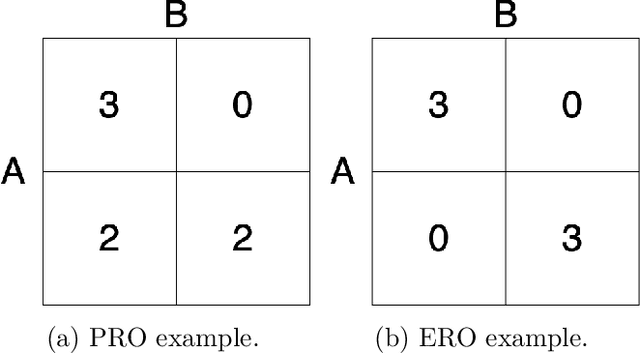

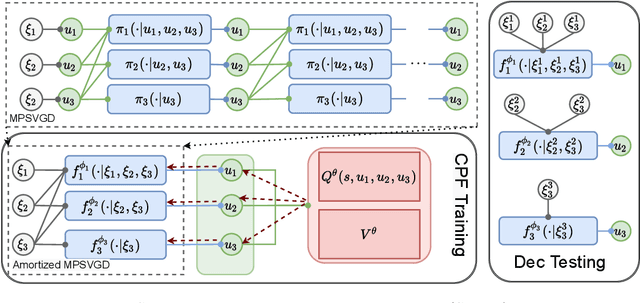
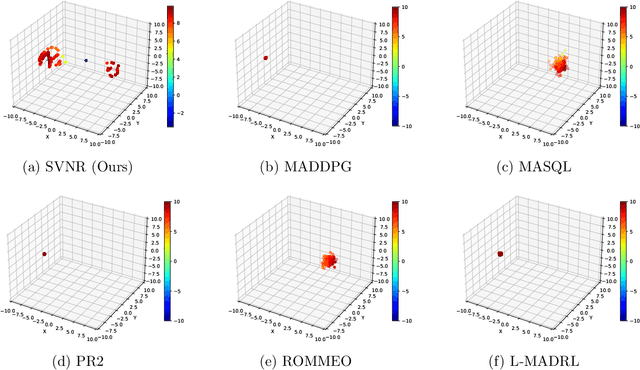
Abstract:Over-generalization is a thorny issue in cognitive science, where people may become overly cautious due to past experiences. Agents in multi-agent reinforcement learning (MARL) also have been found to suffer relative over-generalization (RO) as people do and stuck to sub-optimal cooperation. Recent methods have shown that assigning reasoning ability to agents can mitigate RO algorithmically and empirically, but there has been a lack of theoretical understanding of RO, let alone designing provably RO-free methods. This paper first proves that RO can be avoided when the MARL method satisfies a consistent reasoning requirement under certain conditions. Then we introduce a novel reasoning framework, called negotiated reasoning, that first builds the connection between reasoning and RO with theoretical justifications. After that, we propose an instantiated algorithm, Stein variational negotiated reasoning (SVNR), which uses Stein variational gradient descent to derive a negotiation policy that provably avoids RO in MARL under maximum entropy policy iteration. The method is further parameterized with neural networks for amortized learning, making computation efficient. Numerical experiments on many RO-challenged environments demonstrate the superiority and efficiency of SVNR compared to state-of-the-art methods in addressing RO.
ReAssigner: A Plug-and-Play Virtual Machine Scheduling Intensifier for Heterogeneous Requests
Nov 29, 2022Abstract:With the rapid development of cloud computing, virtual machine scheduling has become one of the most important but challenging issues for the cloud computing community, especially for practical heterogeneous request sequences. By analyzing the impact of request heterogeneity on some popular heuristic schedulers, it can be found that existing scheduling algorithms can not handle the request heterogeneity properly and efficiently. In this paper, a plug-and-play virtual machine scheduling intensifier, called Resource Assigner (ReAssigner), is proposed to enhance the scheduling efficiency of any given scheduler for heterogeneous requests. The key idea of ReAssigner is to pre-assign roles to physical resources and let resources of the same role form a virtual cluster to handle homogeneous requests. ReAssigner can cooperate with arbitrary schedulers by restricting their scheduling space to virtual clusters. With evaluations on the real dataset from Huawei Cloud, the proposed ReAssigner achieves significant scheduling performance improvement compared with some state-of-the-art scheduling methods.
Learning Cooperative Oversubscription for Cloud by Chance-Constrained Multi-Agent Reinforcement Learning
Nov 21, 2022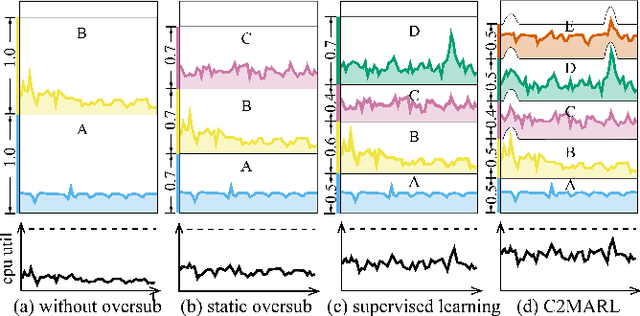
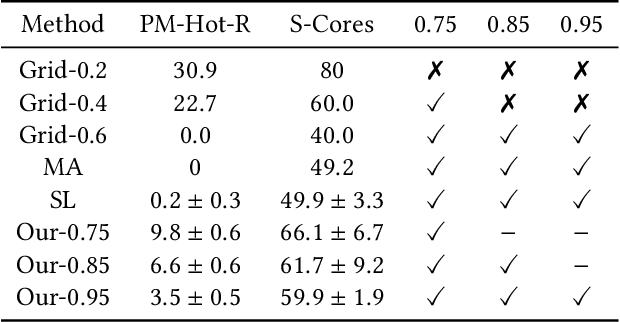
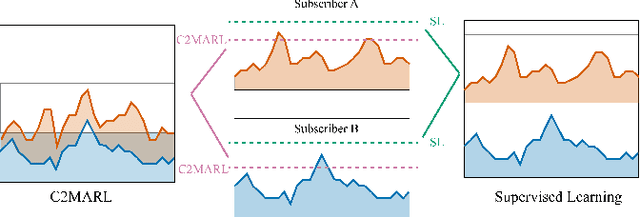
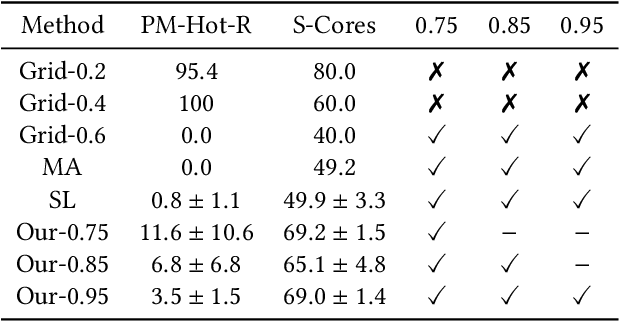
Abstract:Oversubscription is a common practice for improving cloud resource utilization. It allows the cloud service provider to sell more resources than the physical limit, assuming not all users would fully utilize the resources simultaneously. However, how to design an oversubscription policy that improves utilization while satisfying the some safety constraints remains an open problem. Existing methods and industrial practices are over-conservative, ignoring the coordination of diverse resource usage patterns and probabilistic constraints. To address these two limitations, this paper formulates the oversubscription for cloud as a chance-constrained optimization problem and propose an effective Chance Constrained Multi-Agent Reinforcement Learning (C2MARL) method to solve this problem. Specifically, C2MARL reduces the number of constraints by considering their upper bounds and leverages a multi-agent reinforcement learning paradigm to learn a safe and optimal coordination policy. We evaluate our C2MARL on an internal cloud platform and public cloud datasets. Experiments show that our C2MARL outperforms existing methods in improving utilization ($20\%\sim 86\%$) under different levels of safety constraints.
Obtaining Dyadic Fairness by Optimal Transport
Feb 09, 2022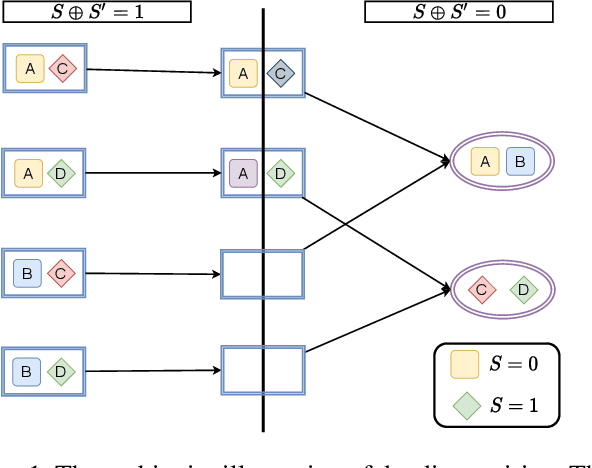

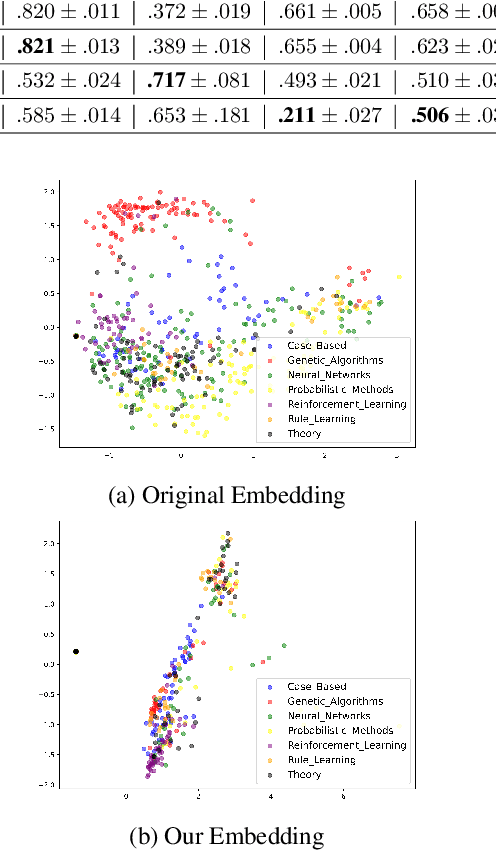

Abstract:Fairness has been taken as a critical metric on machine learning models. Many works studying how to obtain fairness for different tasks emerge. This paper considers obtaining fairness for link prediction tasks, which can be measured by dyadic fairness. We aim to propose a pre-processing methodology to obtain dyadic fairness through data repairing and optimal transport. To obtain dyadic fairness with satisfying flexibility and unambiguity requirements, we transform the dyadic repairing to the conditional distribution alignment problem based on optimal transport and obtain theoretical results on the connection between the proposed alignment and dyadic fairness. The optimal transport-based dyadic fairness algorithm is proposed for graph link prediction. Our proposed algorithm shows superior results on obtaining fairness compared with the other pre-processing methods on two benchmark graph datasets.
VMAgent: Scheduling Simulator for Reinforcement Learning
Dec 09, 2021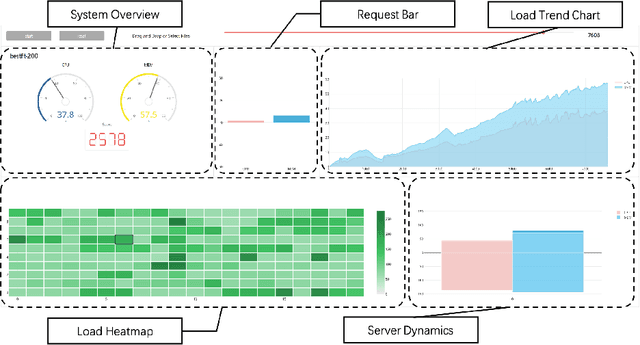
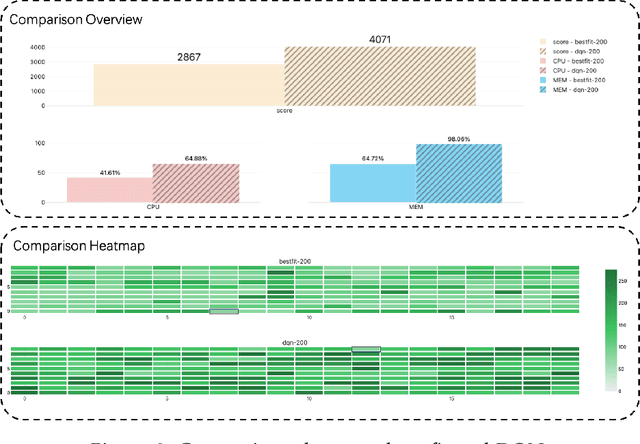
Abstract:A novel simulator called VMAgent is introduced to help RL researchers better explore new methods, especially for virtual machine scheduling. VMAgent is inspired by practical virtual machine (VM) scheduling tasks and provides an efficient simulation platform that can reflect the real situations of cloud computing. Three scenarios (fading, recovering, and expansion) are concluded from practical cloud computing and corresponds to many reinforcement learning challenges (high dimensional state and action spaces, high non-stationarity, and life-long demand). VMAgent provides flexible configurations for RL researchers to design their customized scheduling environments considering different problem features. From the VM scheduling perspective, VMAgent also helps to explore better learning-based scheduling solutions.
Dealing with Non-Stationarity in Multi-Agent Reinforcement Learning via Trust Region Decomposition
Feb 21, 2021



Abstract:Non-stationarity is one thorny issue in multi-agent reinforcement learning, which is caused by the policy changes of agents during the learning procedure. Current works to solve this problem have their own limitations in effectiveness and scalability, such as centralized critic and decentralized actor (CCDA), population-based self-play, modeling of others and etc. In this paper, we novelly introduce a $\delta$-stationarity measurement to explicitly model the stationarity of a policy sequence, which is theoretically proved to be proportional to the joint policy divergence. However, simple policy factorization like mean-field approximation will mislead to larger policy divergence, which can be considered as trust region decomposition dilemma. We model the joint policy as a general Markov random field and propose a trust region decomposition network based on message passing to estimate the joint policy divergence more accurately. The Multi-Agent Mirror descent policy algorithm with Trust region decomposition, called MAMT, is established with the purpose to satisfy $\delta$-stationarity. MAMT can adjust the trust region of the local policies adaptively in an end-to-end manner, thereby approximately constraining the divergence of joint policy to alleviate the non-stationary problem. Our method can bring noticeable and stable performance improvement compared with baselines in coordination tasks of different complexity.
 Add to Chrome
Add to Chrome Add to Firefox
Add to Firefox Add to Edge
Add to Edge